1998 CADILLAC ELDORADO engine overheat
[x] Cancel search: engine overheatPage 261 of 380
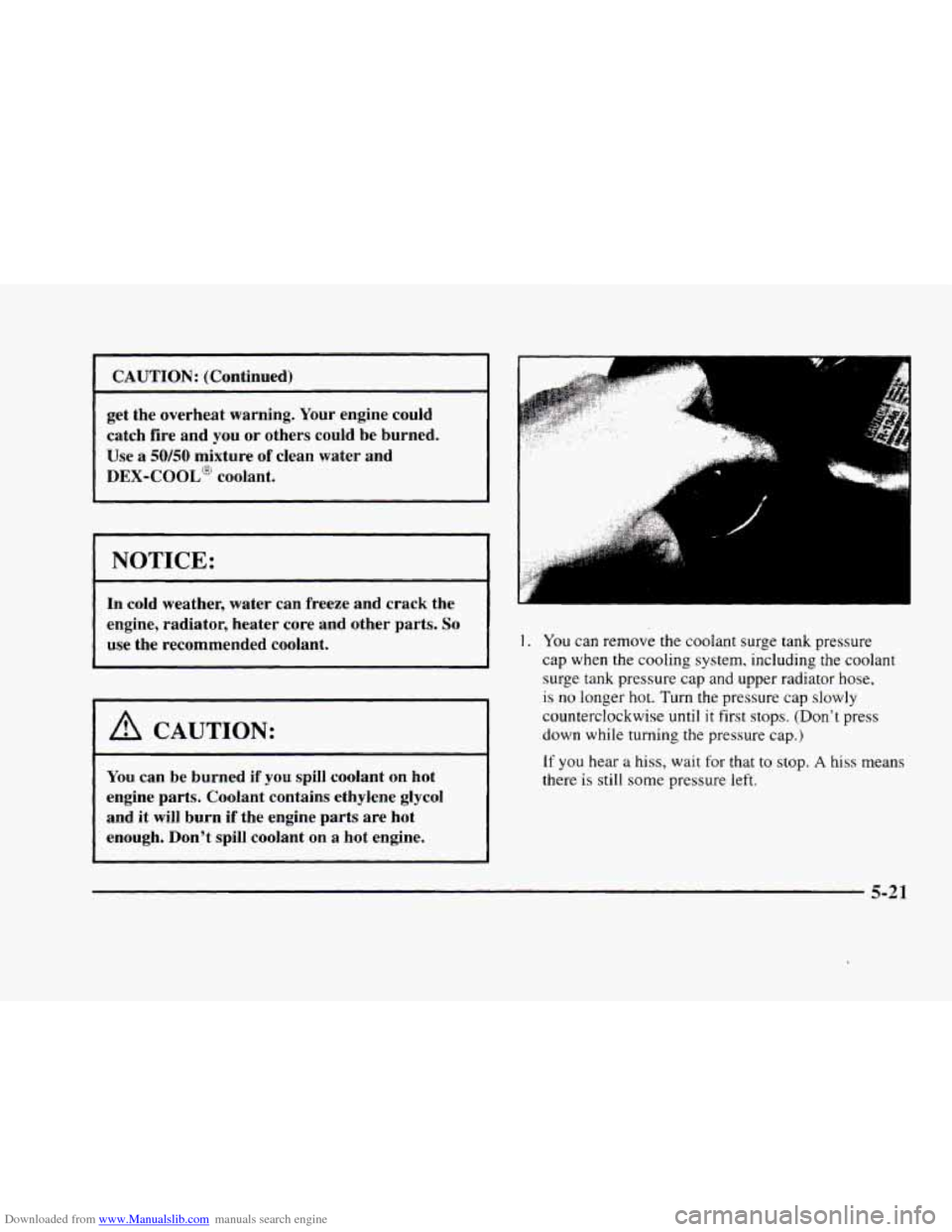
Downloaded from www.Manualslib.com manuals search engine CAUTION: (Continued)
get the overheat warning. Your engine could
catch fire and you
or others could be burned.
Use a 50/50 mixture of clean water and
DEX-COOL@ coolant.
1 NOTICE:
In cold weather, water can freeze and crack the
engine, radiator, heater core and other parts.
So
use the recommended coolant.
I A CAUTION:
You can be burned if you spill coolant on hot
engine parts. Coolant contains ethylene glycol
and it
will burn if the engine parts are hot
enough. Don't spill coolant on a hot engine.
I. You can remove the coolant surge tank pressure
cap when the cooling system, including the coolant
surge tank pressure cap and upper radiator hose,
is no longer hot. Turn the pressure cap slowly
counterclockwise until it first stops. (Don't press
down while turning the pressure cap.)
If you hear a hiss, wait for that to stop. A hiss means
there
is still some pressure left.
5-21
Page 275 of 380
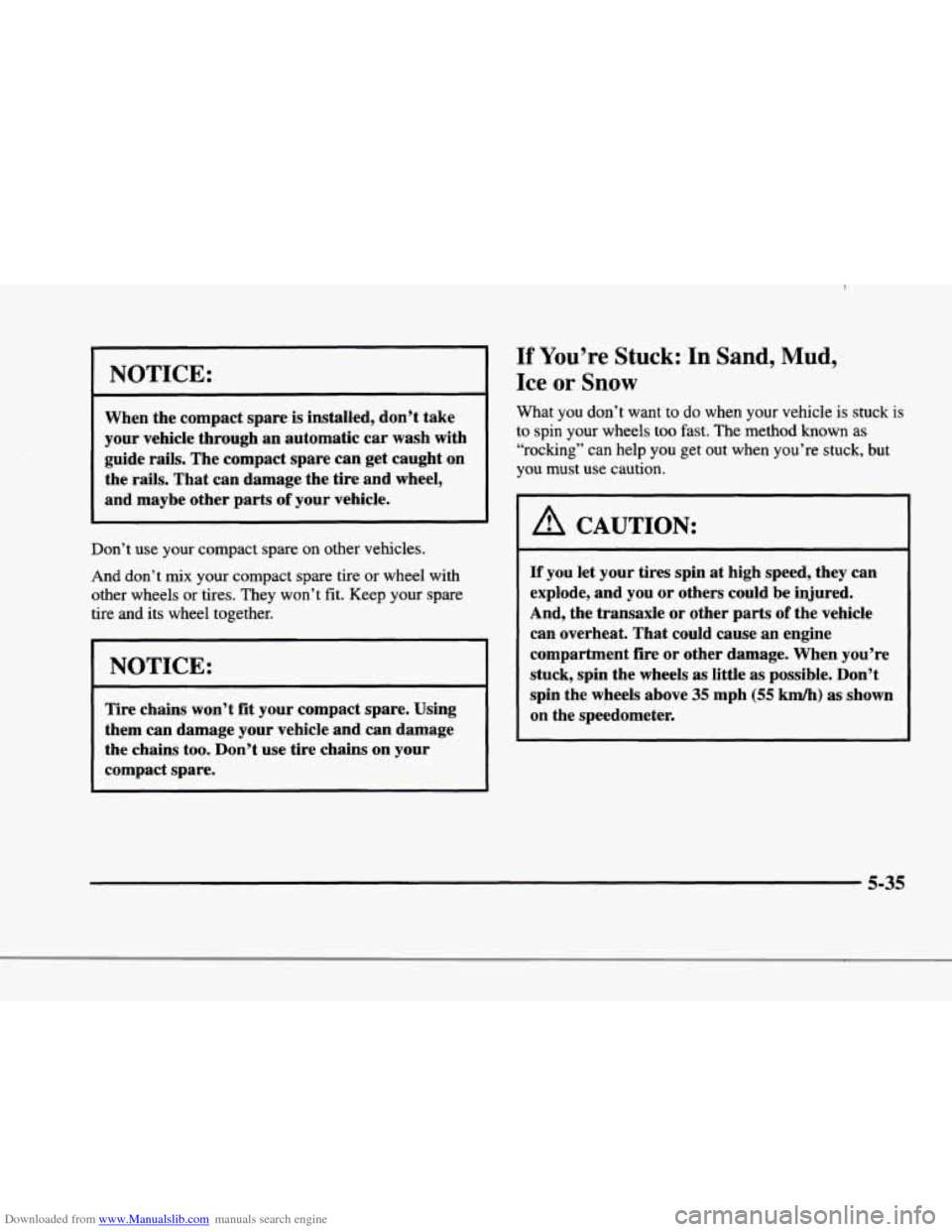
Downloaded from www.Manualslib.com manuals search engine r
r
r
r
2 P
r
r
r
r
NOTICE:
When the compact spare is installed, don’t take
your vehicle through an automatic car wash with
guide rails. The compact spare can get caught
on
the rails. That can damage the tire and wheel,
and maybe other parts
of your vehicle.
Don’t use your compact spare on other vehicles.
And don’t
mix your compact spare tire or wheel with
other wheels or tires. They won’t fit. Keep your spare
tire
and its wheel together.
NOTICE:
Tire chains won’t fit your compact spare. Using
them can damage your vehicle and can damage
the chains too. Don’t use tire chains on your
compact spare.
If You’re Stuck: In Sand, Mud,
Ice or Snow
What you don’t want to do when your vehicle is stuck is
to spin your wheels too fast. The method known
as
“rocking” can help you get out when you’re stuck, but
you must use caution.
A CAUTION:
If you let your tires spin at high speed, they can
explode, and you or others could be injured.
And, the transaxle or other parts
of the vehicle
can overheat. That could cause an engine
compartment fire or other damage. When you’re
stuck, spin the wheels as little
as possible. Don’t
spin the wheels above
35 mph (55 km/h) as shown
on the speedometer.
5-35
Page 302 of 380
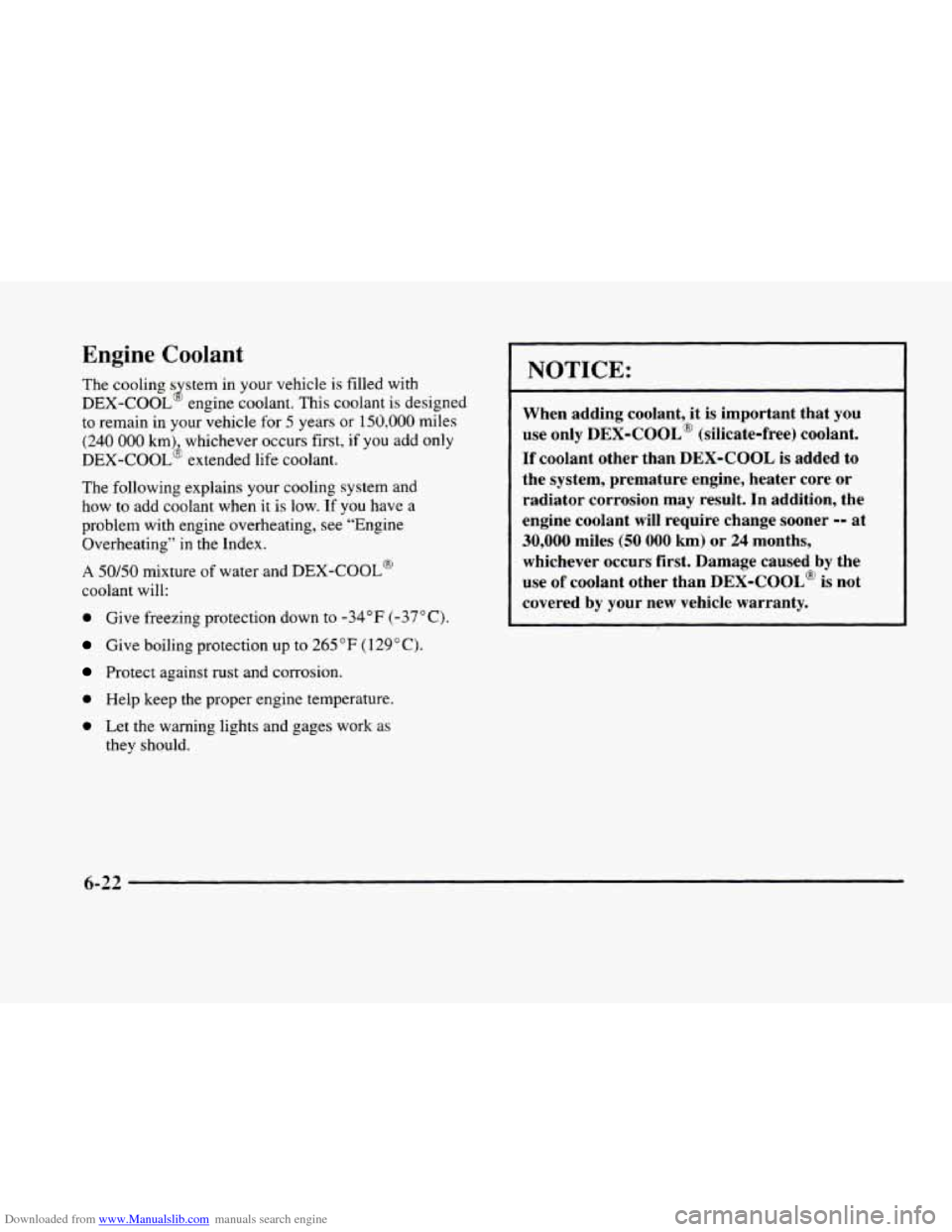
Downloaded from www.Manualslib.com manuals search engine Engine Coolant
The cooling s stem in your vehicle is filled with
DEX-COOL engine coolant. This coolant is designed
to remain in your vehicle for
5 years or 150,000 miles
(240 000 km) whichever occurs first, if you add only
DEX-COOL’ extended life coolant.
J
The following explains your cooling system and
how
to add coolant when it is low. If you have a
problem with engine overheating, see “Engine
Overheating” in the Index.
A 50/50 mixture of water and DEX-COOL@
coolant will:
0 Give freezing protection down to -34°F (-37°C).
Give boiling protection up to 265 “F (1 29°C).
Protect against rust and corrosion.
0 Help keep the proper engine temperature.
0 Let the warning lights and gages work as
they should.
NOTICE:
When adding coolant, it is important that you
use only
DEX-COOL@ (silicate-free) coolant.
If coolant other than DEX-COOL is added to
the system, premature engine, heater core or radiator corrosion may result. In addition, the
engine coolant will require change sooner
-0 at
30,000 miles (50 000 km) or 24 months,
whichever occurs first. Damage caused by the
use
of coolant other than DEX-COOL@ is not
covered by your new vehicle warranty.
6-32
Page 303 of 380

Downloaded from www.Manualslib.com manuals search engine What to Use
Use a mixture of one-half clean water (preferably
distilled) and one-half
DEX-COOL” coolant which
won’t damage aluminum parts.
If you use this mixture.
you don’t need
to add anything else.
A CAUTION:
Adding only plain water to your cooling system
can be dangerous. Plain water, or some other liquid like alcohol, can boil before the proper
coolant mixture will. Your vehicle’s coolant
warning system is set for the proper coolant
mixture. With plain water
or the wrong mixture,
your engine could get too hot but you wouldn’t
get the overheat warning. Your engine could
catch fire and you or others could be burned.
Use a
50/50 mixture of clean water and
DEX-COOL@ coolant.
NOTICE:
If you use an improper coolant mixture, your
engine could overheat and be badly damaged. The repair cost wouldn’t be covered by your
warranty.
Too much water in the mixture can
freeze and crack the engine, radiator, heater
core and other parts.
If you have to add coolant more than four times a year,
have your dealer check your cooling system.
I NOTICE:
~~~~~
If you use the proper coolant, you don’t have to
add extra inhibitors or additives which claim to
improve the system. These can be harmful.
6-23
Page 305 of 380
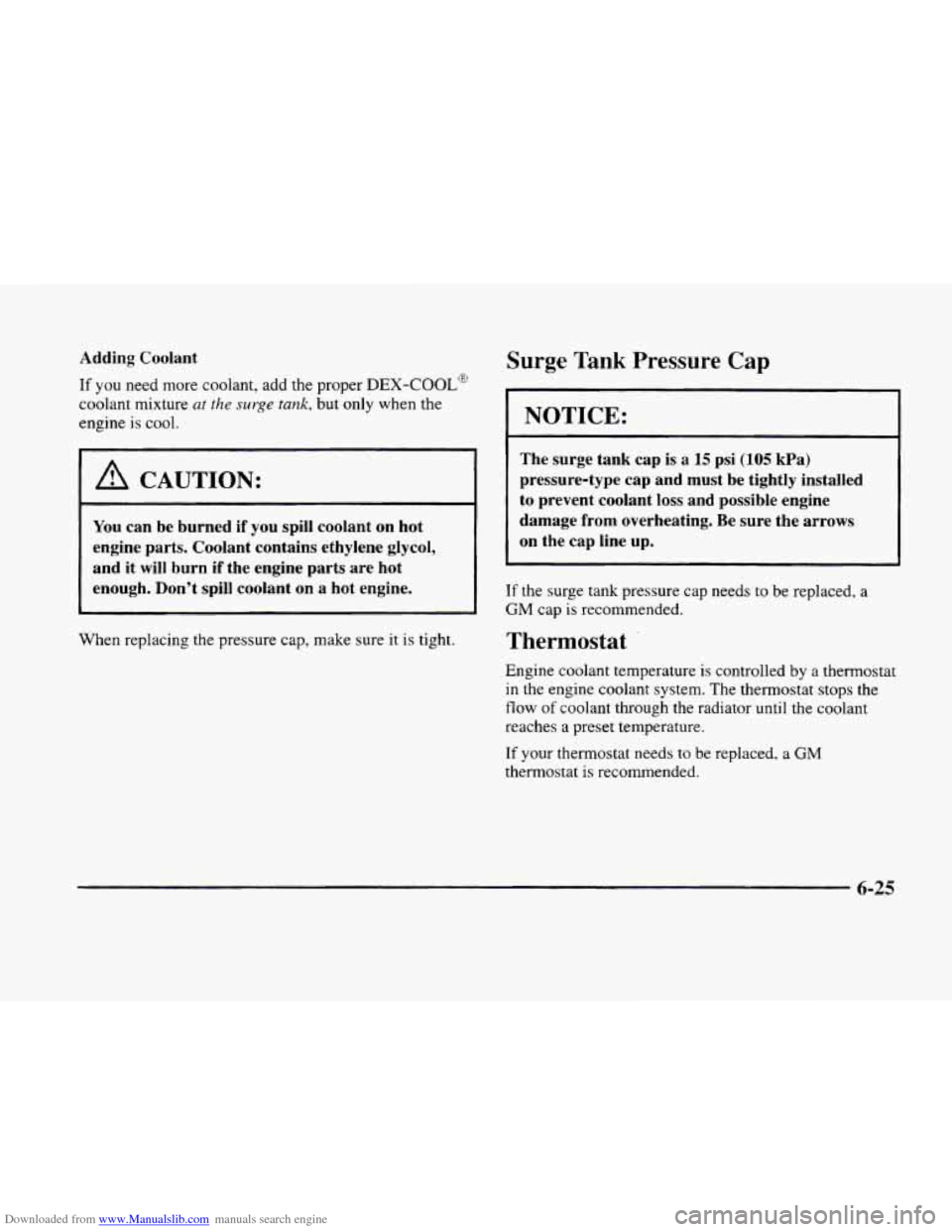
Downloaded from www.Manualslib.com manuals search engine Adding Coolant
If you need more coolant, add the proper DEX-COOL@
coolant mixture ut the surge tank, but only when the
engine
is cool.
I A CAUTION:
You can be burned if you spill coolant on hot
engine parts. Coolant contains ethylene glycol,
and it will burn
if the engine parts are hot
enough. Don’t spill coolant on
a hot engine.
When replacing
the pressure cap, make sure it is tight.
Surge Tank Pressure Cap
NOTICE:
The surge tank cap is a 15 psi (105 kPa)
pressure-type cap and must be tightly installed
to prevent coolant loss and possible engine
damage
from overheating. Be sure the arrows
on the cap line up.
If the surge tank pressure cap needs to be replaced, a
GM cap is recommended.
Thermostat
Engine coolant temperature is controlled by a thermostat
in the engine coolant system. The thermostat stops the
flow
of coolant through the radiator until the coolant
reaches a preset temperature.
If your thermostat needs to be replaced. a GM
thermostat is recommended.
6-25
Page 319 of 380
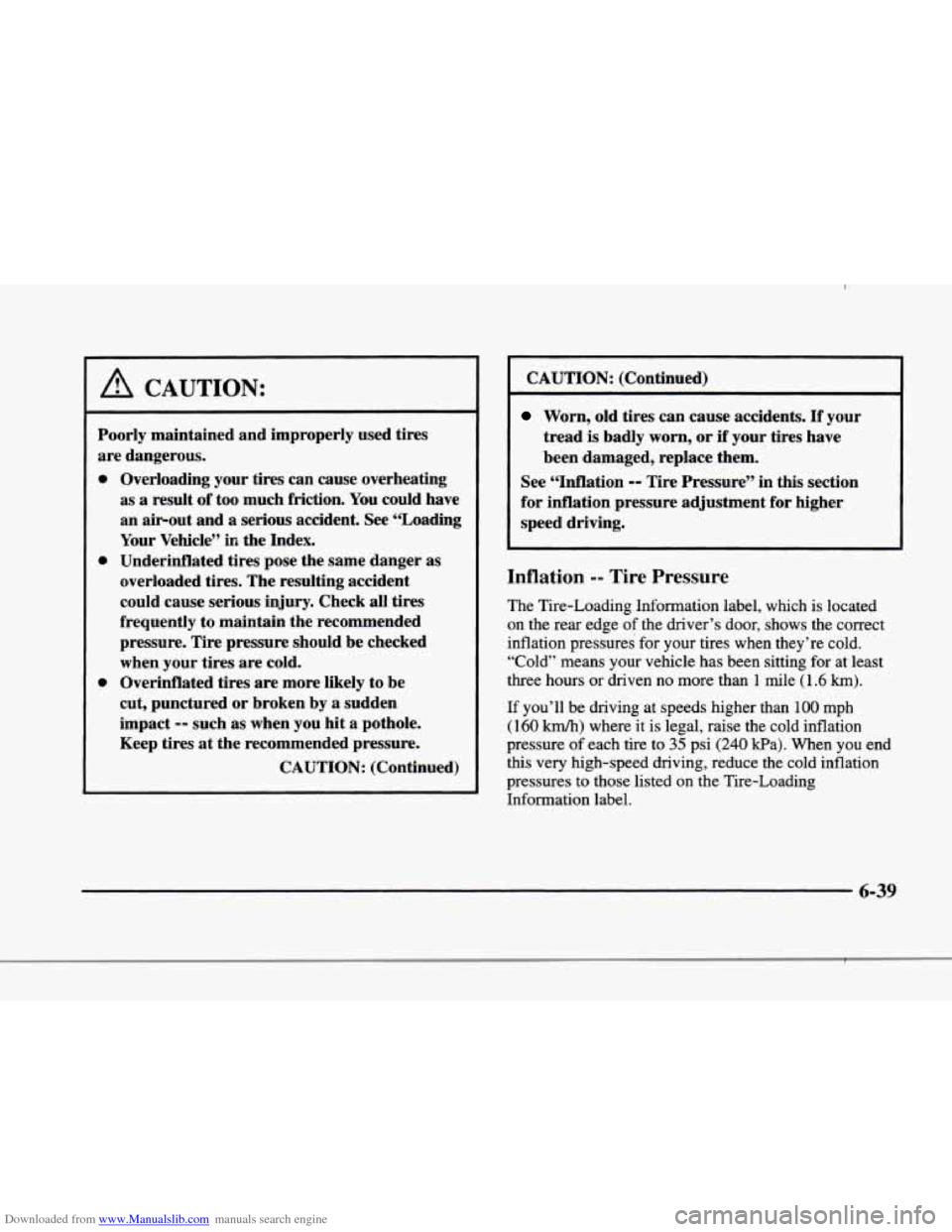
Downloaded from www.Manualslib.com manuals search engine r
r
!
r
I
r
r
I
r
I- t
A CAUTION:
~~ ~~
Poorly maintained and improperly used tires
are dangerous.
0
0
0
Overloading your tires can cause overheating
as a result of too much friction. You could have
an air-out and a serious accident. See “Loading
Your Vehicle”
h the Index.
UnderinfJated tires pose the same danger as
overloaded tires. The resulting accident
could cause serious injury. Check all tires
frequently to maintain the recommended
pressure. Tire pressure should be checked
when your tires are cold.
Overinflated tires are more likely to be
cut, punctured or broken by a sudden
impact
-- such as when you hit a pothole.
Keep tires at the recommended pressure.
CAUTION: (Continued) CAUTION: (Continued)
Worn, old
tires can cause accidents. If your
tread
is badly worn, or if your tires have
been damaged, replace them.
See “Inflation
-- Tire Pressure” in this section
for inflation pressure adjustment for higher
speed driving.
Inflation -- Tire Pressure
The Tire-Loading Information label, which is located
on the rear edge of the driver’s door, shows the correct
inflation pressures for your tires when they’re cold.
“Cold” means your vehicle has been sitting for at least
three hours or driven
no more than 1 mile (1.6 km).
If you’ll be driving at speeds higher than 100 mph
(160 km/h) where it is legal, raise the cold inflation
pressure of each tire to
35 psi (240 kPa). When you end
this very high-speed driving, reduce the cold inflation
pressures
to those listed on the Tire-Loading
Information label.
6-39
Page 336 of 380

Downloaded from www.Manualslib.com manuals search engine Headlamp Wiring
The headlamp wiring has an individual fuse which is
powered by a MaxiFuse@. An electrical overload
will cause the lamps to
go on and off, or in some
cases
to remain off. If this happens, have the headlamp
wiring checked right away.
MaxiFuse is a registered trademark
of Little
Fuse Incorporated.
Windshield Wiper Fuses
The windshield wiper motor is powered by a MaxiFuse.
If the motor overheats due to heavy snow, etc., the
wipers will stop until the
motor cools. If the overload
is caused
by some electrical problem, be sure to have
it fixed.
Power Windows and Other Power Options
Circuit breakers protect the power windows and other
power accessories. When the current load is
too heavy,
the circuit breaker opens and closes, protecting the
circuit until the problem
is fixed or goes away.
MaxiFusesmelay Center
The MaxiFuses and relays are located next to the engine
compartment fuse block
on the driver's side of the
engine. To access the compartment fuse block, remove
the shroud, cover.
If a MaxiFuse should blow, have your
vehicle serviced by your dealer immediately.
RELAY CENTER IDENTIFICATION
(WINDOWS)
RELAY
91
Page 366 of 380
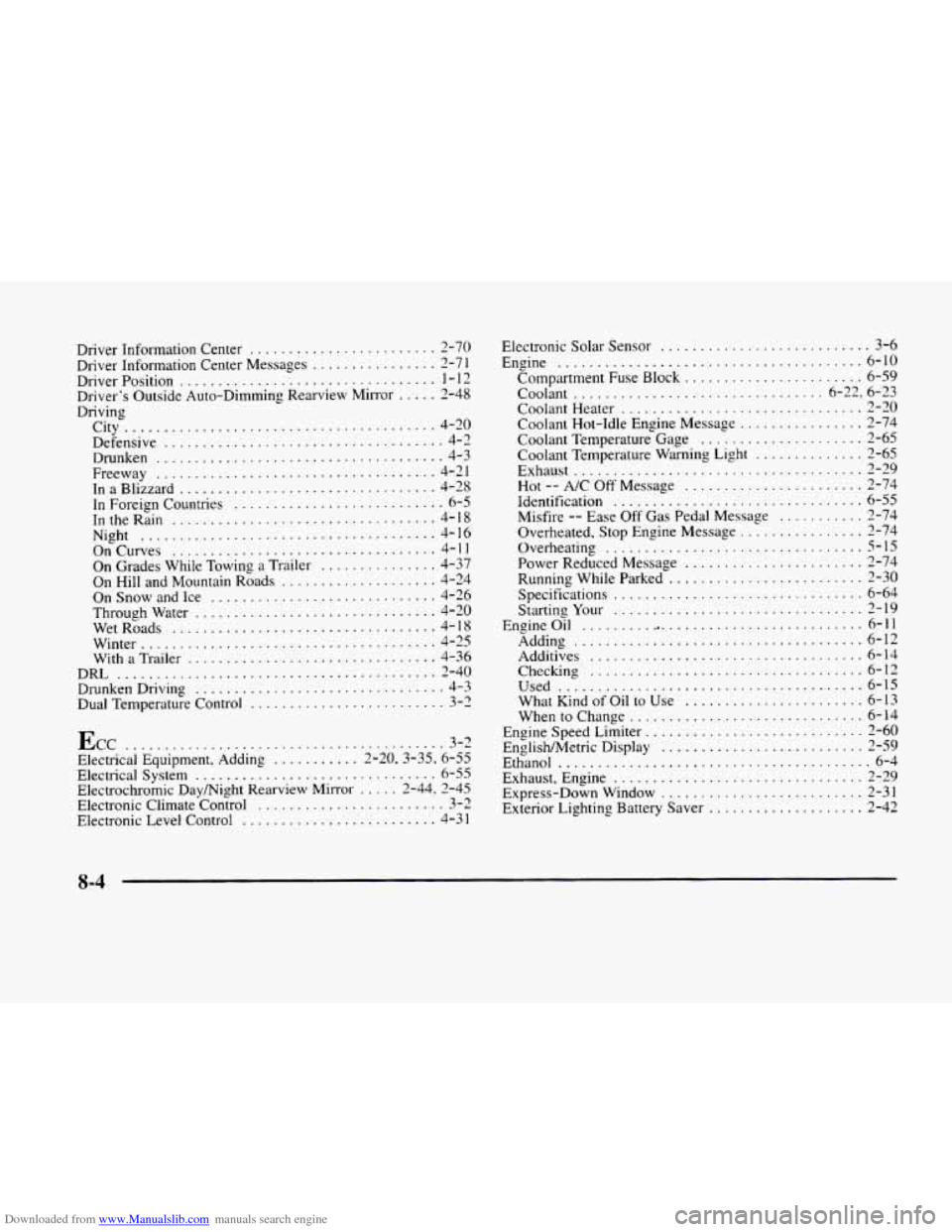
Downloaded from www.Manualslib.com manuals search engine Driver Information Center ........................ 2-70
Driver Information Center Messages
................ 2-7 1
Driver's Outside Auto-Dimming Rearview Mirror ..... 2-48
DriverPosition
................................. 1-12
Driving
City
........................................ 4-20
Defensive
.................................... 4-2
Drunken
..................................... 4-3
Freeway
.................................... 4-21
InaBlizzard
................................. 4-28
In Foreign Countries ........................... 6-5
In the Rain .................................. 4-18
On Curves
.................................. 4- 1 1
On Grades While Towing a Trailer ............... 4-37
On Hill and Mountain Roads
.................... 4-24
On Snow and Ice
............................. 4-26
Night
...................................... 4-16
Throughwater ............................... 4-20
WetRoads
.................................. 4-18
Winter ...................................... 4-25 With a Trailer ................................ 4-36
DRL ......................................... 2-40
DrunkenDriving
................................ 4-3
Dual Temperature Control
......................... 3-2
Ecc ......................................... 3-2
Electrical Equipment . Adding ........... 2.20. 3.35. 6-55
Electrical System ............................... 6-55
Electrochromic Daymight Rearview Mirror ..... 2.44. 2-45
Electrcnic Climate Control
........................ 3-2
Electronic Level Control ......................... 4-3 I
Electronic Solar Sensor ........................... 3-6
Engine ....................................... 6-10
Compartment Fuse Block ....................... 6-59
Coolant
................................ 6-22, 6-23
Coolant Heater ............................... 2-20
Coolant Hot-Idle Engine Message ................ 2-74
Coolant Temperature Gage
..................... 2-65
Coolant Temperature Wdming Light .............. 2-65
Exhaust ..................................... 3-29
Hot
-- A/C Off Message ....................... 2-74
Identification
................................ 6-55
Misfire
-- Ease Off Gas Pedal Message ........... 2-74
Overheated
. Stop Engine Message ................ 2-74
Overheating ................................. 5-15
Power Reduced Message ....................... 2-74
Running While Parked
......................... 2-30
Specifications
................................ 6-64
Starting Your ................................ 2-19
Engineoil
..................................... 6-11
Adding ..................................... 6-12
Additives
................................... 6-14
Checking ................................... 6-12
Used ....................................... 6-15
What Kind
of Oil to Use ....................... 6-13
Whentochange .............................. 6-14
EnglisNMetric Display .......................... 2-59
Ethanol ........................................ 6-4
Exhaust, Engine
................................ 2-29
Engine
Speed Limiter
............................ 2-60
Express-Down Window .......................... 2-31
Exterior Lighting Battery Saver
.................... 2-42
8-4